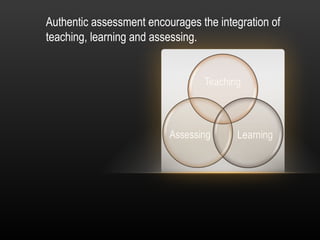
Authentic assessment steps 1 4
- 1. Authentic assessment encourages the integration of teaching, learning and assessing.
- 2. Photo by: Runs with Scissors 1. An authentic assessment 2. And a scoring includes an authentic task guide/rubric by which their for students to perform. performance on the task will be evaluated.
- 3. Think of authentic assessment development in four steps
- 4. Step 1: Indentify your Objectives (Outcomes) Objectives (Outcomes) are a description of what a student is expected to attain in order to meet a specified learning outcome or objective. Objectives (Outcomes) are typically one-sentence statements of what students should know and be able to do at a certain point. Photo by: Pragmagraphr
- 5. An authentic task is an assignment to assess how learners apply objective- driven knowledge and skills to real-world challenges. We are less interested in how much information students can acquire than how well they can use it.
- 6. ASK "What does good performance on this task look like?" or "How will I know they have done a good job on this task?" These questions identify the criteria for good performance on the task. The criteria is used to evaluate how well students completed the task, and how well they have met your objectives.
- 9. Give the criteria to students before they begin a task Criteria should be given to students before they begin a task to: •Know the instructor's expectations. •Recognize what a good performance should look like.
- 10. Criteria Poor (1) Good (2) Excellent (3) A rubric, or scoring scale, is typically created to measure student performance against Number of Sources x1 1-4 5-9 10-12 your set of criteria. The rubric contains the Historical Accuracy x3 Lots of historical Few inaccuracies No apparent essential criteria for the task inaccuracies inaccuracies and appropriate levels of performance for each criterion. Organization x1 Can not tell from Can tell with Can easily tell which Example which source difficulty where sources info was This rubric (scoring scale) information came information came drawn from covers the research portion of a from project. Bibliography x1 Bibliography Bibliography All relevant contains very little contains most information is information relevant included information
- 11. Levels of Performance Criteria Poor (1) Good (2) Excellent (3) A rubric is comprised of two components: criteria and levels of performance. Number of Sources x1 1-4 5-9 10-12 •Every rubric has at least two criteria and at least two levels Historical Accuracy x3 Lots of historical Few inaccuracies No apparent of performance. inaccuracies inaccuracies •The criteria, characteristics of good performance on a task, Organization x1 Can not tell from Can tell with Can easily tell which are listed in the left-hand which source difficulty where sources info was column in the rubric. information came information came drawn from from •For each criterion, determine to what degree the student has met the level of performance. Bibliography x1 Bibliography contains Bibliography All relevant very little contains most information is information relevant included information
- 12. Criteria Poor (1) Good (2) Excellent (3) In the second-to-left column of a rubric a weight is assigned to each criterion. Number of Sources x1 1-4 5-9 10-12 Example •Students can receive 1, 2 or 3 Historical Accuracy x3 Lots of historical Few inaccuracies No apparent points for "number of sources." inaccuracies inaccuracies But historical accuracy is weighted three times (x3) as heavily. Organization x1 Can not tell from Can tell with Can easily tell which which source difficulty where sources info was •Students can receive 3, 6 or 9 information came information came drawn from points (i.e., 1, 2 or 3 times 3) for from the level of accuracy in their projects. Bibliography x1 Bibliography contains Bibliography All relevant very little contains most information is information relevant included information
- 13. Criteria Poor (1) Good (2) Excellent (3) Descriptors describe what is expected of students at each Number of x1 1-4 5-9 10-12 level of performance for each Sources criterion. Historical x3 Lots of historical Few inaccuracies No apparent •A descriptor tells students Accuracy inaccuracies inaccuracies more precisely what performance looks like at each level and how their work may Organization x1 Can not tell from Can tell with Can easily tell be distinguished from the work which source difficulty where which sources info of others for each criterion. information came information came was drawn from from •Students will be more certain what is expected to reach each level of performance on the Bibliography x1 Bibliography Bibliography All relevant rubric if descriptors are contains very little contains most information is provided. information relevant included information •A descriptor helps the instructor more precisely and consistently distinguish between student work.
- 14. When you first construct and use a rubric you might not include descriptors. Criteria Poor (1) Good (2) Excellent (3) For example, imagine we strip the rubric of its descriptors and Number of Sources x1 put in labels for each level instead. Historical Accuracy x3 You might just include the Organization x1 criteria and some type of labels for the levels of performance. Bibliography x1 After you have used the rubric and identified student work that fits into each level it will become easier to articulate what you mean by "good" or "excellent."
- 15. The criteria are characteristics of good performance on a task. • What are the 6 recommended guidelines for each criterion? • Write one criterion for one of your tasks by applying each of the 6 recommended guidelines.
- 16. Writing Good Descriptors for Each Level of Performance and Each Criterion is not Easy 1. What do descriptors describe? 2. How do descriptors help: a) Students b) Teachers 3. Write one descriptor for the criterion you previously wrote.
